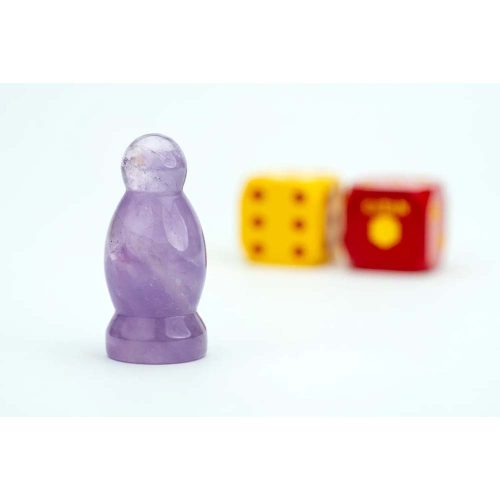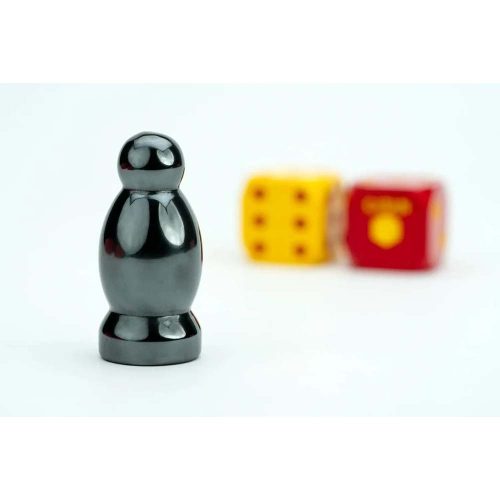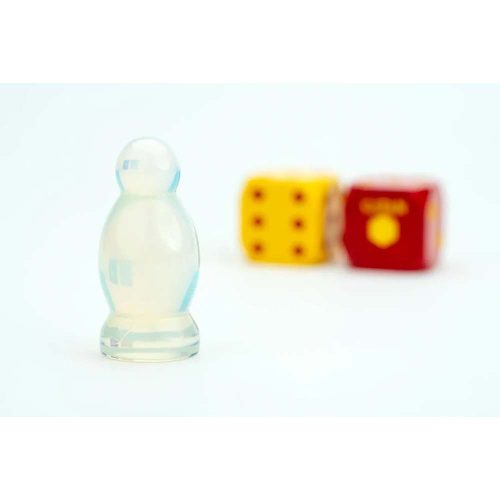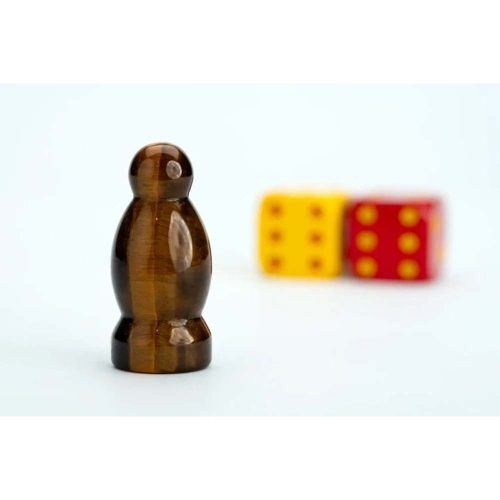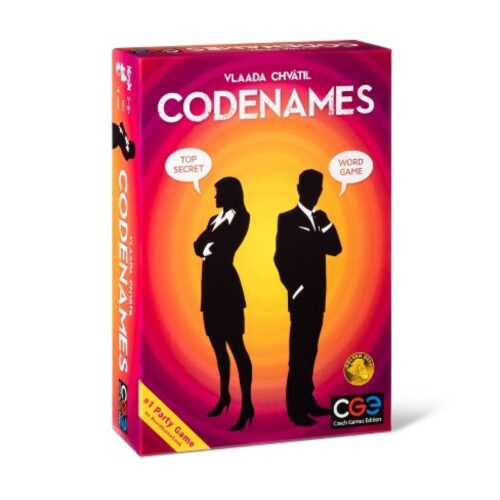 Codenames is an easy party game to solve puzzles. The game is divided into red and blue, each side has a team leader, the team leader's goal is to lead their team to the final victory. At the beginning of the game, there will be 25 cards on the table with different words. Each card has a corresponding position, representing different colors. Only the team leader can see the color of the card. The team leader should prompt according to the words, let his team members find out the cards of their corresponding colors, and find out all the cards of their own colors to win.
Codenames is an easy party game to solve puzzles. The game is divided into red and blue, each side has a team leader, the team leader's goal is to lead their team to the final victory. At the beginning of the game, there will be 25 cards on the table with different words. Each card has a corresponding position, representing different colors. Only the team leader can see the color of the card. The team leader should prompt according to the words, let his team members find out the cards of their corresponding colors, and find out all the cards of their own colors to win.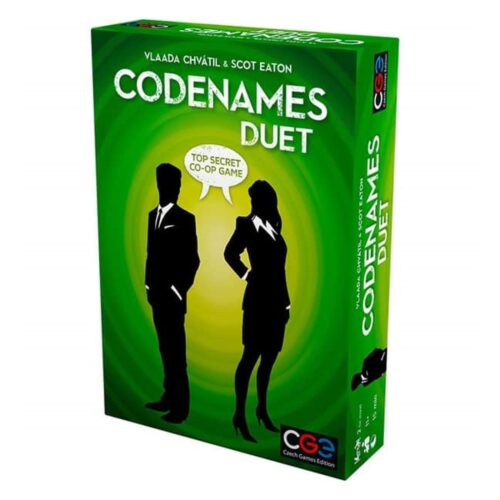 Codenames Duet keeps the basic elements of Codenames Give one-word clues to try to get someone to identify your agents among those on the table! But now you're working together as a team to find all of your agents. (Why you don't already know who your agents are is a question that Congressional investigators will get on your back about later!) To set up play, lay out 25 word cards in a 5x5 grid. Place a key card in the holder so that each player sees one side of the card. Each player sees a 5x5 grid on the card, with nine of the squares colored green (representing your agents) and three squares colored black (representing assassins). Three of the nine squares on each side are also green on the other side, one assassin is black on both sides, one is green on the other side and the other is an innocent bystander on the other side. Collectively, you need to reveal all fifteen agents - without revealing an assassin - before time runs out in order to win the game. Either player can decide to give the first one-word clue to the other player, along with a number. Whoever receives the clue places a finger on a card to identify that agent. If correct, they can attempt to identify another one. If they identify a bystander, then their guessing time ends. If they identify an assassin, you both lose! Unlike regular Codenames, they can keep guessing as long as they keep identifying an agent each time; this is useful for going back to previous clues and finding ones they missed earlier. After the first clue is given, players alternate giving clues.
Codenames Duet keeps the basic elements of Codenames Give one-word clues to try to get someone to identify your agents among those on the table! But now you're working together as a team to find all of your agents. (Why you don't already know who your agents are is a question that Congressional investigators will get on your back about later!) To set up play, lay out 25 word cards in a 5x5 grid. Place a key card in the holder so that each player sees one side of the card. Each player sees a 5x5 grid on the card, with nine of the squares colored green (representing your agents) and three squares colored black (representing assassins). Three of the nine squares on each side are also green on the other side, one assassin is black on both sides, one is green on the other side and the other is an innocent bystander on the other side. Collectively, you need to reveal all fifteen agents - without revealing an assassin - before time runs out in order to win the game. Either player can decide to give the first one-word clue to the other player, along with a number. Whoever receives the clue places a finger on a card to identify that agent. If correct, they can attempt to identify another one. If they identify a bystander, then their guessing time ends. If they identify an assassin, you both lose! Unlike regular Codenames, they can keep guessing as long as they keep identifying an agent each time; this is useful for going back to previous clues and finding ones they missed earlier. After the first clue is given, players alternate giving clues.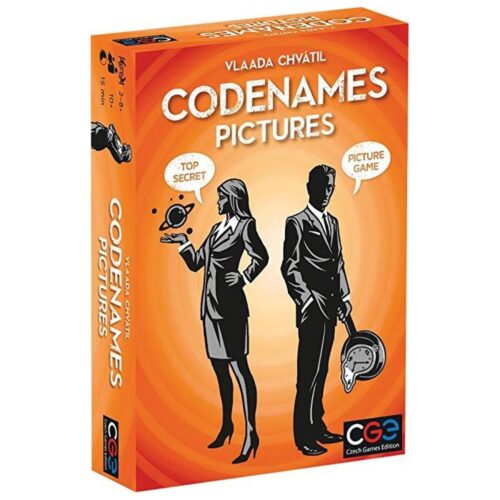 What are these strange symbols on the map? They are code for locations where spies must contact secret agents! Two rival spymasters know the agent in each location. They deliver coded messages telling their field operatives where to go for clandestine meetings. Operatives must be clever. A decoding mistake could lead to an unpleasant encounter with an enemy agent - or worse, with the assassin! Both teams race to contact all their agents, but only one team can win. Codenames: Pictures differs from the original Codenames in that the agents are no longer represented by a single word, but by an image that contains multiple elements.
What are these strange symbols on the map? They are code for locations where spies must contact secret agents! Two rival spymasters know the agent in each location. They deliver coded messages telling their field operatives where to go for clandestine meetings. Operatives must be clever. A decoding mistake could lead to an unpleasant encounter with an enemy agent - or worse, with the assassin! Both teams race to contact all their agents, but only one team can win. Codenames: Pictures differs from the original Codenames in that the agents are no longer represented by a single word, but by an image that contains multiple elements.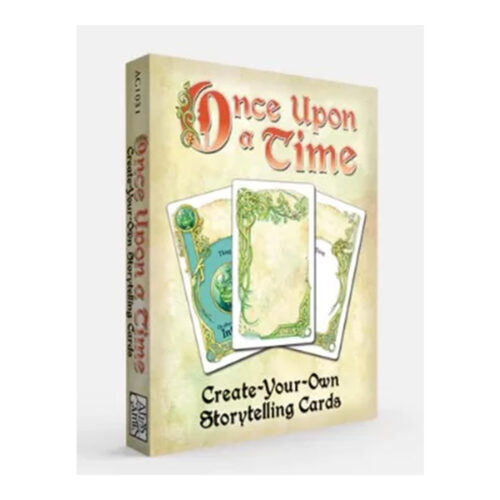 Create-Your-Own Storytelling Cards at a Glance Add unique variety to your Once Upon a Time games. Personalize blank Story and Ending cards. Contains a total of 55 cards and requires Once Upon a Time to play. Tell Your Own Tales: More about Create-Your-Own Storytelling Cards Once Upon a Time is a storytelling game in which players work together to tell fairy tales based on topics in their cards. Add personalized flair to your game with this set of blank cards. Add doodles and story elements to each card and shuffle them into the deck. With these cards, you can integrate in-jokes, favorite characters, and more. Will your princess play soccer, or will your troll settle at the North Pole with Santa Claus? Anything is possible with this expansion!
Create-Your-Own Storytelling Cards at a Glance Add unique variety to your Once Upon a Time games. Personalize blank Story and Ending cards. Contains a total of 55 cards and requires Once Upon a Time to play. Tell Your Own Tales: More about Create-Your-Own Storytelling Cards Once Upon a Time is a storytelling game in which players work together to tell fairy tales based on topics in their cards. Add personalized flair to your game with this set of blank cards. Add doodles and story elements to each card and shuffle them into the deck. With these cards, you can integrate in-jokes, favorite characters, and more. Will your princess play soccer, or will your troll settle at the North Pole with Santa Claus? Anything is possible with this expansion!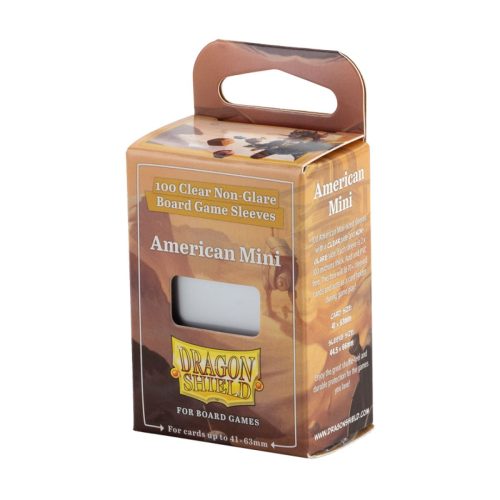 Expected Release Date: June 2025 Dragon Shield's sleeves for board games are made to last and designed leveraging their 25 years of experience keeping games safe and helping players relax and enjoy worry-free game nights. Dragon Shield: Board Game Sleeves keep your cards safe from spilled drinks and greasy fingers, make shuffling easy, and keep your games looking pristine without being marred by dings and scratches. The unique combination of both a Clear and a Non-Glare side makes the shuffle feel delightfully smooth while letting you decide which side to use for the front of the card and which to use for the back depending on your preference. Each pack comes with 100 American Mini sleeves that fit board game cards measuring up to 41x63 mm. Keep the box to store and neatly organize 70+ sleeved cards in your games. Great for games like Arkham Horror, Arkham Horror: The Card Game, Twilight Imperium, Zombicide, Champions of Midgard, & many more! Specifications: Quantity: 100 sleeves Sleeve Size: 44.5 x 66 mm Card Size: up to 41 x 63 mm
Expected Release Date: June 2025 Dragon Shield's sleeves for board games are made to last and designed leveraging their 25 years of experience keeping games safe and helping players relax and enjoy worry-free game nights. Dragon Shield: Board Game Sleeves keep your cards safe from spilled drinks and greasy fingers, make shuffling easy, and keep your games looking pristine without being marred by dings and scratches. The unique combination of both a Clear and a Non-Glare side makes the shuffle feel delightfully smooth while letting you decide which side to use for the front of the card and which to use for the back depending on your preference. Each pack comes with 100 American Mini sleeves that fit board game cards measuring up to 41x63 mm. Keep the box to store and neatly organize 70+ sleeved cards in your games. Great for games like Arkham Horror, Arkham Horror: The Card Game, Twilight Imperium, Zombicide, Champions of Midgard, & many more! Specifications: Quantity: 100 sleeves Sleeve Size: 44.5 x 66 mm Card Size: up to 41 x 63 mm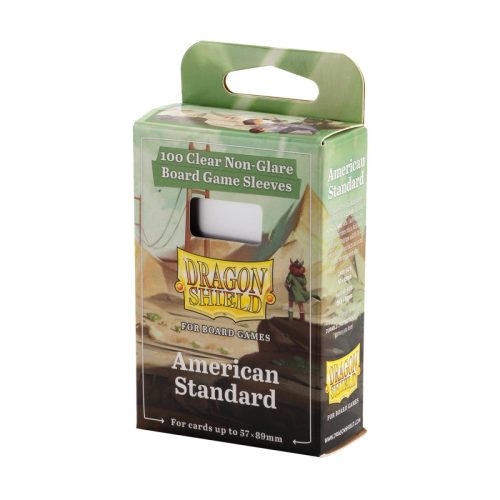 Expected Release Date: June 2025 Dragon Shield's sleeves for board games are made to last and designed leveraging their 25 years of experience keeping games safe and helping players relax and enjoy worry-free game nights. Dragon Shield: Board Game Sleeves keep your cards safe from spilled drinks and greasy fingers, make shuffling easy, and keep your games looking pristine without being marred by dings and scratches. The unique combination of both a Clear and a Non-Glare side makes the shuffle feel delightfully smooth while letting you decide which side to use for the front of the card and which to use for the back depending on your preference. Each pack comes with 100 American Standard sleeves that fit board game cards measuring up to 57x89 mm. Keep the box to store and neatly organize 70+ sleeved cards in your games. Great for games like Wingspan, The Crew, Heat: Pedal to the Metal, Ticket to Ride: Europe, Arkham Horror, Scout, Champions of Midgard, & many more! Specifications: Quantity: 100 sleeves Sleeve Size: 59.5 x 92 mm Card Size: up to 57 x 89 mm
Expected Release Date: June 2025 Dragon Shield's sleeves for board games are made to last and designed leveraging their 25 years of experience keeping games safe and helping players relax and enjoy worry-free game nights. Dragon Shield: Board Game Sleeves keep your cards safe from spilled drinks and greasy fingers, make shuffling easy, and keep your games looking pristine without being marred by dings and scratches. The unique combination of both a Clear and a Non-Glare side makes the shuffle feel delightfully smooth while letting you decide which side to use for the front of the card and which to use for the back depending on your preference. Each pack comes with 100 American Standard sleeves that fit board game cards measuring up to 57x89 mm. Keep the box to store and neatly organize 70+ sleeved cards in your games. Great for games like Wingspan, The Crew, Heat: Pedal to the Metal, Ticket to Ride: Europe, Arkham Horror, Scout, Champions of Midgard, & many more! Specifications: Quantity: 100 sleeves Sleeve Size: 59.5 x 92 mm Card Size: up to 57 x 89 mm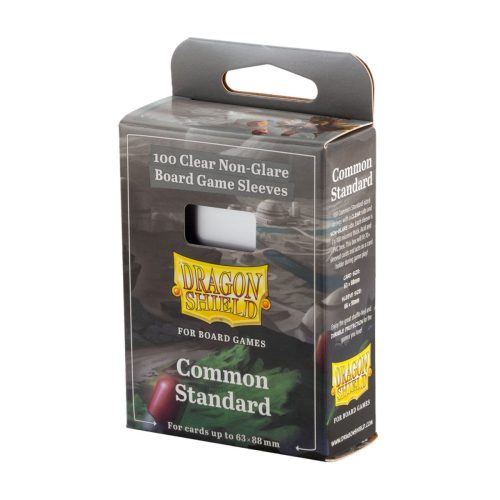 Expected Release Date: June 2025 Dragon Shield's sleeves for board games are made to last and designed leveraging their 25 years of experience keeping games safe and helping players relax and enjoy worry-free game nights. Dragon Shield: Board Game Sleeves keep your cards safe from spilled drinks and greasy fingers, make shuffling easy, and keep your games looking pristine without being marred by dings and scratches. The unique combination of both a Clear and a Non-Glare side makes the shuffle feel delightfully smooth while letting you decide which side to use for the front of the card and which to use for the back depending on your preference. Each pack comes with 100 Common Standard sleeves that fit board game cards measuring up to 63x88 mm. Keep the box to store and neatly organize 70+ sleeved cards in your games. Great for games like Gloomhaven, Frosthaven, Dune Imperium, Terraforming Mars, Spirit Island, Pandemic, Arkham Horror: The Card Game, Ark Nova, Everdell, Arcs, Root, Brass: Birmingham, Clank!, Hero Realms, Mysterium, & many more! Specifications: Quantity: 100 sleeves Sleeve Size: 66 x 91 mm Card Size: up to 63 x 88 mm
Expected Release Date: June 2025 Dragon Shield's sleeves for board games are made to last and designed leveraging their 25 years of experience keeping games safe and helping players relax and enjoy worry-free game nights. Dragon Shield: Board Game Sleeves keep your cards safe from spilled drinks and greasy fingers, make shuffling easy, and keep your games looking pristine without being marred by dings and scratches. The unique combination of both a Clear and a Non-Glare side makes the shuffle feel delightfully smooth while letting you decide which side to use for the front of the card and which to use for the back depending on your preference. Each pack comes with 100 Common Standard sleeves that fit board game cards measuring up to 63x88 mm. Keep the box to store and neatly organize 70+ sleeved cards in your games. Great for games like Gloomhaven, Frosthaven, Dune Imperium, Terraforming Mars, Spirit Island, Pandemic, Arkham Horror: The Card Game, Ark Nova, Everdell, Arcs, Root, Brass: Birmingham, Clank!, Hero Realms, Mysterium, & many more! Specifications: Quantity: 100 sleeves Sleeve Size: 66 x 91 mm Card Size: up to 63 x 88 mm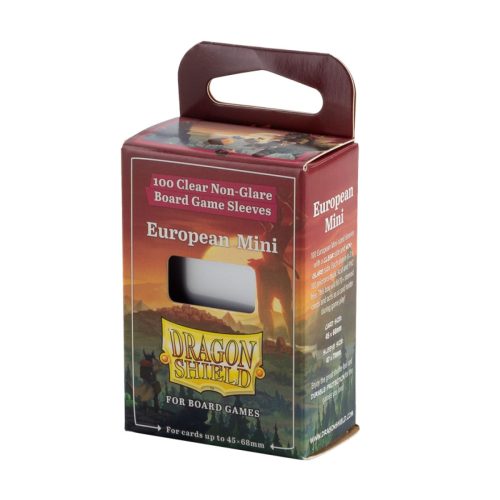 Expected Release Date: June 2025 Dragon Shield's sleeves for board games are made to last and designed leveraging their 25 years of experience keeping games safe and helping players relax and enjoy worry-free game nights. Dragon Shield: Board Game Sleeves keep your cards safe from spilled drinks and greasy fingers, make shuffling easy, and keep your games looking pristine without being marred by dings and scratches. The unique combination of both a Clear and a Non-Glare side makes the shuffle feel delightfully smooth while letting you decide which side to use for the front of the card and which to use for the back depending on your preference. Each pack comes with 100 European Mini sleeves that fit board game cards measuring up to 45x68 mm. Keep the box to store and neatly organize 70+ sleeved cards in your games. Great for games like Gloomhaven, Frosthaven, 7 Wonders Duel, The Crew, Scythe, Spirit Island, Ticket to Ride, Codenames, & many more! Specifications: Quantity: 100 sleeves Sleeve Size: 47 x 71 mm Card Size: up to 45 x 68 mm
Expected Release Date: June 2025 Dragon Shield's sleeves for board games are made to last and designed leveraging their 25 years of experience keeping games safe and helping players relax and enjoy worry-free game nights. Dragon Shield: Board Game Sleeves keep your cards safe from spilled drinks and greasy fingers, make shuffling easy, and keep your games looking pristine without being marred by dings and scratches. The unique combination of both a Clear and a Non-Glare side makes the shuffle feel delightfully smooth while letting you decide which side to use for the front of the card and which to use for the back depending on your preference. Each pack comes with 100 European Mini sleeves that fit board game cards measuring up to 45x68 mm. Keep the box to store and neatly organize 70+ sleeved cards in your games. Great for games like Gloomhaven, Frosthaven, 7 Wonders Duel, The Crew, Scythe, Spirit Island, Ticket to Ride, Codenames, & many more! Specifications: Quantity: 100 sleeves Sleeve Size: 47 x 71 mm Card Size: up to 45 x 68 mm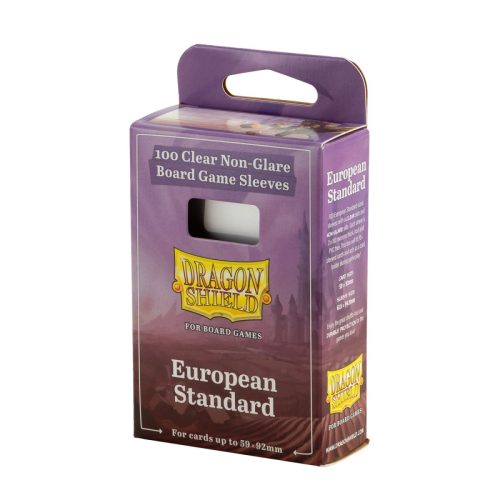 Expected Release Date: June 2025 Dragon Shield's sleeves for board games are made to last and designed leveraging their 25 years of experience keeping games safe and helping players relax and enjoy worry-free game nights. Dragon Shield: Board Game Sleeves keep your cards safe from spilled drinks and greasy fingers, make shuffling easy, and keep your games looking pristine without being marred by dings and scratches. The unique combination of both a Clear and a Non-Glare side makes the shuffle feel delightfully smooth while letting you decide which side to use for the front of the card and which to use for the back depending on your preference. Each pack comes with 100 European Standard sleeves that fit board game cards measuring up to 59x92 mm. Keep the box to store and neatly organize 70+ sleeved cards in your games. Great for games like Wyrmspan, Concordia, Agricola, & many more! Specifications: Quantity: 100 sleeves Sleeve Size: 61.5 x 94.5 mm Card Size: up to 59 x 92 mm
Expected Release Date: June 2025 Dragon Shield's sleeves for board games are made to last and designed leveraging their 25 years of experience keeping games safe and helping players relax and enjoy worry-free game nights. Dragon Shield: Board Game Sleeves keep your cards safe from spilled drinks and greasy fingers, make shuffling easy, and keep your games looking pristine without being marred by dings and scratches. The unique combination of both a Clear and a Non-Glare side makes the shuffle feel delightfully smooth while letting you decide which side to use for the front of the card and which to use for the back depending on your preference. Each pack comes with 100 European Standard sleeves that fit board game cards measuring up to 59x92 mm. Keep the box to store and neatly organize 70+ sleeved cards in your games. Great for games like Wyrmspan, Concordia, Agricola, & many more! Specifications: Quantity: 100 sleeves Sleeve Size: 61.5 x 94.5 mm Card Size: up to 59 x 92 mm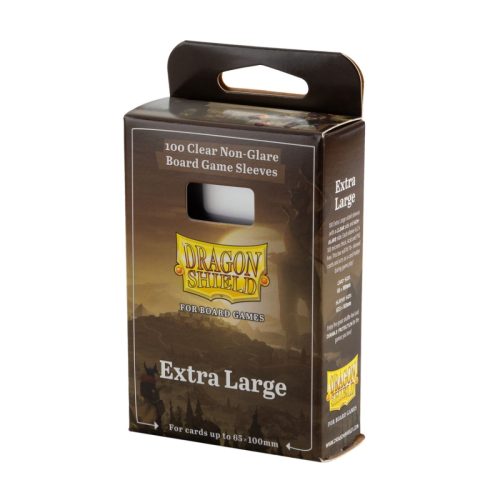 Expected Release Date: June 2025 Dragon Shield's sleeves for board games are made to last and designed leveraging their 25 years of experience keeping games safe and helping players relax and enjoy worry-free game nights. Dragon Shield: Board Game Sleeves keep your cards safe from spilled drinks and greasy fingers, make shuffling easy, and keep your games looking pristine without being marred by dings and scratches. The unique combination of both a Clear and a Non-Glare side makes the shuffle feel delightfully smooth while letting you decide which side to use for the front of the card and which to use for the back depending on your preference. Each pack comes with 100 Extra Large sleeves that fit board game cards measuring up to 65x100 mm. Keep the box to store and neatly organize 70+ sleeved cards in your games. Great for games like 7 Wonders, Abyss, Raptor, Mr. Jack, The Pursuit of Happiness, & many more! Specifications: Quantity: 100 sleeves Sleeve Size: 67.5 x 103 mm Card Size: up to 65 x 100 mm
Expected Release Date: June 2025 Dragon Shield's sleeves for board games are made to last and designed leveraging their 25 years of experience keeping games safe and helping players relax and enjoy worry-free game nights. Dragon Shield: Board Game Sleeves keep your cards safe from spilled drinks and greasy fingers, make shuffling easy, and keep your games looking pristine without being marred by dings and scratches. The unique combination of both a Clear and a Non-Glare side makes the shuffle feel delightfully smooth while letting you decide which side to use for the front of the card and which to use for the back depending on your preference. Each pack comes with 100 Extra Large sleeves that fit board game cards measuring up to 65x100 mm. Keep the box to store and neatly organize 70+ sleeved cards in your games. Great for games like 7 Wonders, Abyss, Raptor, Mr. Jack, The Pursuit of Happiness, & many more! Specifications: Quantity: 100 sleeves Sleeve Size: 67.5 x 103 mm Card Size: up to 65 x 100 mm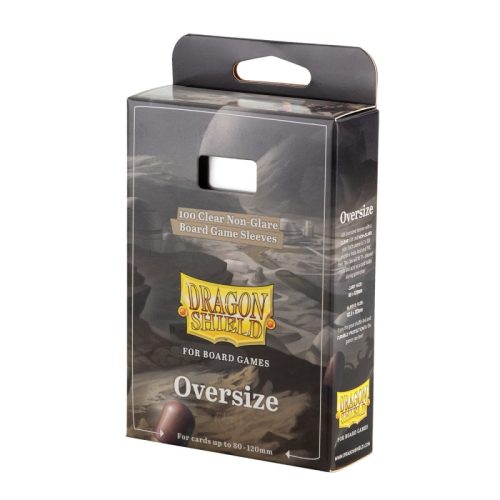 Expected Release Date: June 2025 Dragon Shield's sleeves for board games are made to last and designed leveraging their 25 years of experience keeping games safe and helping players relax and enjoy worry-free game nights. Dragon Shield: Board Game Sleeves keep your cards safe from spilled drinks and greasy fingers, make shuffling easy, and keep your games looking pristine without being marred by dings and scratches. The unique combination of both a Clear and a Non-Glare side makes the shuffle feel delightfully smooth while letting you decide which side to use for the front of the card and which to use for the back depending on your preference. Each pack comes with 100 Oversize sleeves that fit board game cards measuring up to 80x120 mm. Keep the box to store and neatly organize 70+ sleeved cards in your games. Specifications: Quantity: 100 sleeves Sleeve Size: 82.5 x 123 mm Card Size: up to 80 x 120 mm
Expected Release Date: June 2025 Dragon Shield's sleeves for board games are made to last and designed leveraging their 25 years of experience keeping games safe and helping players relax and enjoy worry-free game nights. Dragon Shield: Board Game Sleeves keep your cards safe from spilled drinks and greasy fingers, make shuffling easy, and keep your games looking pristine without being marred by dings and scratches. The unique combination of both a Clear and a Non-Glare side makes the shuffle feel delightfully smooth while letting you decide which side to use for the front of the card and which to use for the back depending on your preference. Each pack comes with 100 Oversize sleeves that fit board game cards measuring up to 80x120 mm. Keep the box to store and neatly organize 70+ sleeved cards in your games. Specifications: Quantity: 100 sleeves Sleeve Size: 82.5 x 123 mm Card Size: up to 80 x 120 mm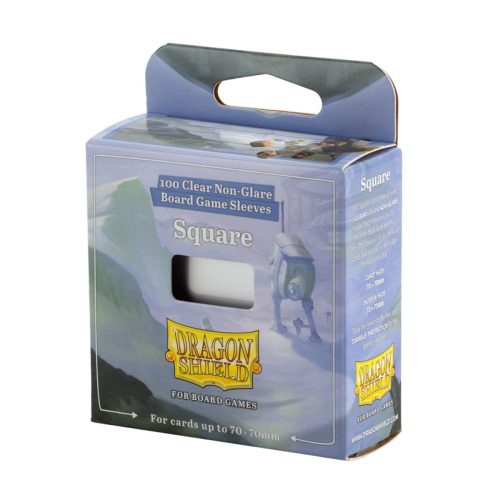 Expected Release Date: June 2025 Dragon Shield's sleeves for board games are made to last and designed leveraging their 25 years of experience keeping games safe and helping players relax and enjoy worry-free game nights. Dragon Shield: Board Game Sleeves keep your cards safe from spilled drinks and greasy fingers, make shuffling easy, and keep your games looking pristine without being marred by dings and scratches. The unique combination of both a Clear and a Non-Glare side makes the shuffle feel delightfully smooth while letting you decide which side to use for the front of the card and which to use for the back depending on your preference. Each pack comes with 100 Square sleeves that fit board game cards measuring up to 70x70 mm. Keep the box to store and neatly organize 70+ sleeved cards in your games. Specifications: Quantity: 100 sleeves Sleeve Size: 72 x 73 mm Card Size: up to 70 x 70 mm
Expected Release Date: June 2025 Dragon Shield's sleeves for board games are made to last and designed leveraging their 25 years of experience keeping games safe and helping players relax and enjoy worry-free game nights. Dragon Shield: Board Game Sleeves keep your cards safe from spilled drinks and greasy fingers, make shuffling easy, and keep your games looking pristine without being marred by dings and scratches. The unique combination of both a Clear and a Non-Glare side makes the shuffle feel delightfully smooth while letting you decide which side to use for the front of the card and which to use for the back depending on your preference. Each pack comes with 100 Square sleeves that fit board game cards measuring up to 70x70 mm. Keep the box to store and neatly organize 70+ sleeved cards in your games. Specifications: Quantity: 100 sleeves Sleeve Size: 72 x 73 mm Card Size: up to 70 x 70 mm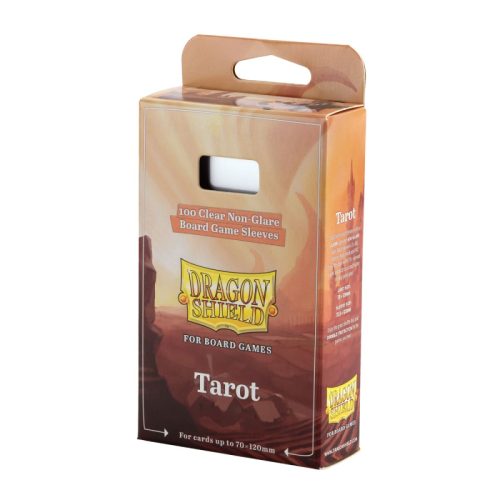 Expected Release Date: June 2025 Dragon Shield's sleeves for board games are made to last and designed leveraging their 25 years of experience keeping games safe and helping players relax and enjoy worry-free game nights. Dragon Shield: Board Game Sleeves keep your cards safe from spilled drinks and greasy fingers, make shuffling easy, and keep your games looking pristine without being marred by dings and scratches. The unique combination of both a Clear and a Non-Glare side makes the shuffle feel delightfully smooth while letting you decide which side to use for the front of the card and which to use for the back depending on your preference. Each pack comes with 100 Tarot sleeves that fit board game cards measuring up to 70x120 mm. Keep the box to store and neatly organize 70+ sleeved cards in your games Great for games like War of the Ring, T.I.M.E Stories, Elder Sign, Century: Spice Road, & many more! Specifications: Quantity: 100 sleeves Sleeve Size: 72.5 x 123 mm Card Size: up to 70 x 120 mm
Expected Release Date: June 2025 Dragon Shield's sleeves for board games are made to last and designed leveraging their 25 years of experience keeping games safe and helping players relax and enjoy worry-free game nights. Dragon Shield: Board Game Sleeves keep your cards safe from spilled drinks and greasy fingers, make shuffling easy, and keep your games looking pristine without being marred by dings and scratches. The unique combination of both a Clear and a Non-Glare side makes the shuffle feel delightfully smooth while letting you decide which side to use for the front of the card and which to use for the back depending on your preference. Each pack comes with 100 Tarot sleeves that fit board game cards measuring up to 70x120 mm. Keep the box to store and neatly organize 70+ sleeved cards in your games Great for games like War of the Ring, T.I.M.E Stories, Elder Sign, Century: Spice Road, & many more! Specifications: Quantity: 100 sleeves Sleeve Size: 72.5 x 123 mm Card Size: up to 70 x 120 mm


